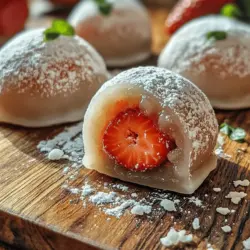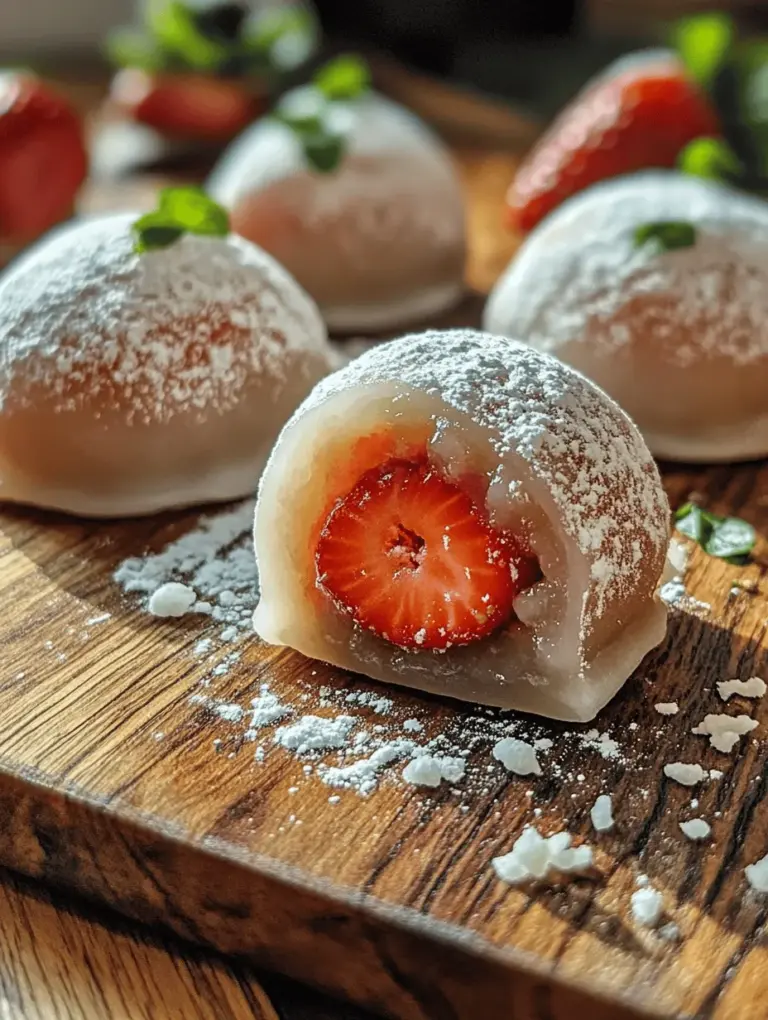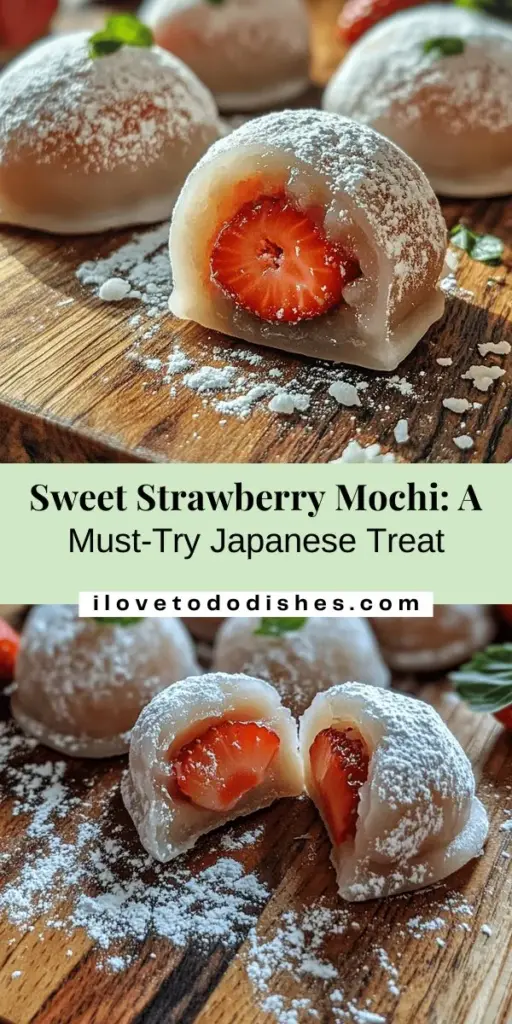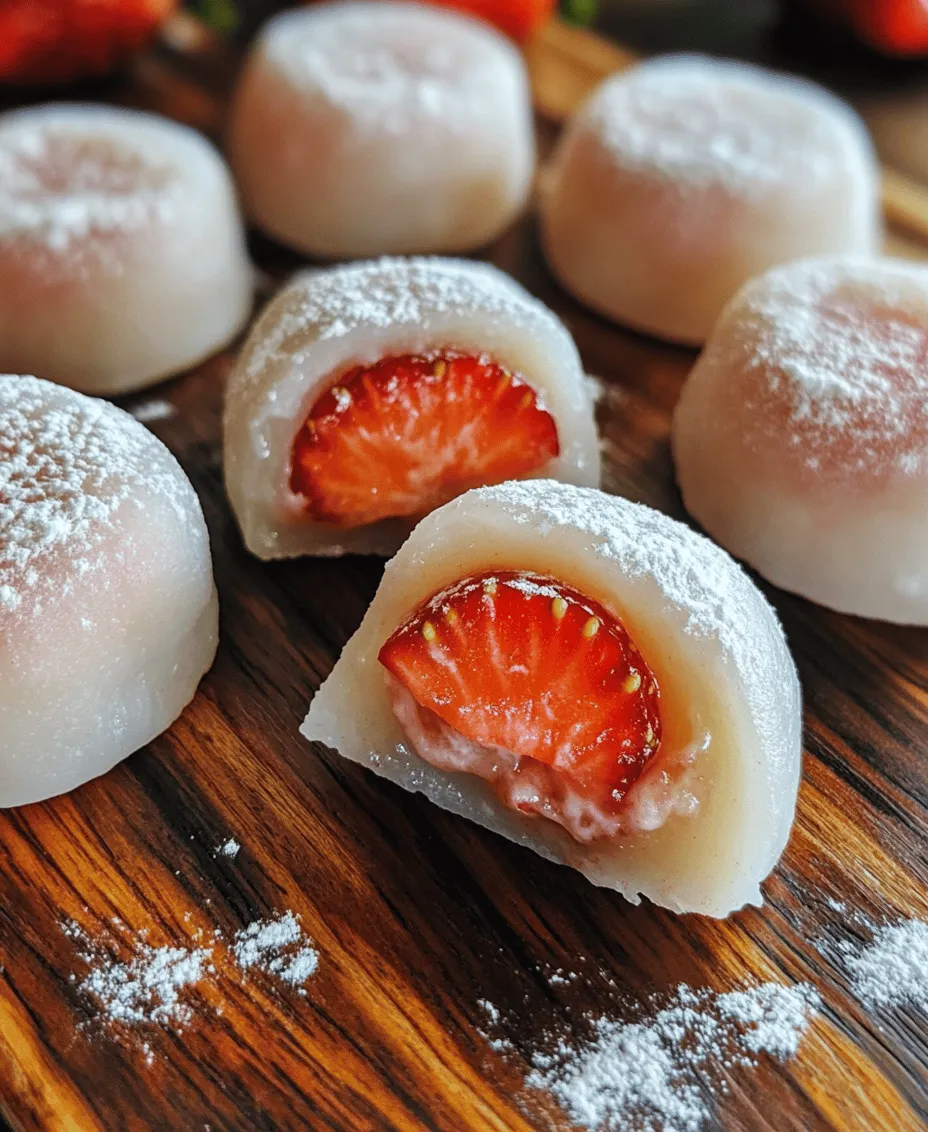Introduction
Welcome to the delightful world of Japanese desserts! Among the many treasures found in this culinary landscape, one treat stands out for its unique combination of flavors and textures: Strawberry Mochi. This charming dessert is not only a feast for the palate but also a treat for the eyes. With its chewy exterior encasing a fresh strawberry, Strawberry Mochi has become a beloved choice among dessert enthusiasts both in Japan and around the world.
Mochi, a traditional Japanese rice cake, has a rich history that dates back centuries. Its cultural significance is deeply rooted in Japanese customs, often associated with celebrations and rituals. The versatility of mochi allows it to be enjoyed in various forms, but when paired with the sweetness of ripe strawberries, it transforms into a delicacy that captivates the senses. The combination of the chewy texture of the mochi and the juicy burst of fresh strawberries creates a harmonious balance that is simply irresistible.
In this article, we will explore the origins and characteristics of mochi, delve into what makes Strawberry Mochi special, break down the ingredients required for this recipe, and provide you with a detailed step-by-step guide to making this delightful dessert at home.
Understanding Mochi
Definition and Characteristics of Mochi
Mochi is a traditional Japanese rice cake made from glutinous rice, also known as sticky rice or sweet rice. The rice is steamed and then pounded until it becomes a smooth, sticky paste. This process gives mochi its signature chewy texture, making it a unique treat that can be both savory and sweet. While mochi may be simple in its ingredients, its versatility allows it to take on various flavors and forms, from sweet desserts to savory dishes.
Historical Significance and Cultural Context
Mochi has a long-standing history in Japan, tracing back over a thousand years. Initially, it was used as a staple food, particularly during festivals and celebrations. In Japanese culture, mochi is often associated with good fortune and prosperity. During the New Year, for example, a special rice cake called “kagamimochi” is prepared to symbolize the hope for a bountiful year ahead.
As time passed, the uses of mochi expanded, and it became a popular ingredient in various dishes. Today, mochi is enjoyed year-round, with different regional variations and flavors. Its cultural significance remains strong, often featured in traditional sweets known as “wagashi,” which are enjoyed during tea ceremonies.
Different Types of Mochi and Their Uses
There are several types of mochi, each varying in texture and flavor. Some popular varieties include:
– Daifuku Mochi: A sweet mochi stuffed with various fillings, such as red bean paste, ice cream, or fruit.
– Kuzumochi: Made from kudzu starch, this variety has a softer texture and is often served with syrup or sweet toppings.
– Inarizushi: Although not a dessert, this savory version features mochi wrapped around sushi rice and often served in a sweet soy sauce.
These variations showcase the versatility of mochi, making it an essential component of Japanese cuisine.
Why Strawberry Mochi is Special
The Fusion of Flavors: Sweet Strawberries and Chewy Mochi
Strawberry Mochi is a delightful fusion of flavors that elevates the traditional mochi experience. The sweetness of fresh strawberries complements the subtle flavor of the mochi, creating a taste sensation that is both refreshing and satisfying. When you bite into a piece of Strawberry Mochi, the soft, chewy exterior gives way to the juicy sweetness of the strawberry, making every bite a delightful explosion of flavor.
Visual Appeal: Vibrant Colors and Unique Presentation
One of the standout features of Strawberry Mochi is its visual appeal. The bright red of the strawberries contrasts beautifully with the pale, milky color of the mochi, creating an eye-catching dessert that is perfect for special occasions or gatherings. The presentation of these little morsels can be as creative as you like, making them a captivating addition to any dessert platter.
Versatility: Variations and Serving Suggestions
Strawberry Mochi is not only delicious but also incredibly versatile. While the classic version features fresh strawberries, you can experiment with various fillings and flavors. For instance, you can use different fruits, such as mango or blueberries, or incorporate flavored mochi dough using matcha or cocoa powder. Additionally, serving Strawberry Mochi with a side of sweetened red bean paste or drizzled with chocolate sauce can add an extra layer of indulgence.
Ingredients Breakdown
To prepare delicious Strawberry Mochi, you’ll need a few key ingredients. Here’s a comprehensive overview:
Glutinous Rice Flour: Properties and Alternatives
The primary ingredient in mochi is glutinous rice flour, also known as “mochi flour” or “sweet rice flour.” This special flour is made from short-grain glutinous rice, which gives mochi its characteristic chewy texture. When cooking with glutinous rice flour, it’s essential to use the right type, as regular rice flour will not yield the same results.
If you are looking for alternatives, you might consider using tapioca flour or a gluten-free blend. However, keep in mind that these substitutions may alter the texture slightly.
Sugar: Types and How They Affect Sweetness
Sugar plays a crucial role in sweetening the mochi dough. Typically, granulated sugar is used, but you can also experiment with other types such as brown sugar or coconut sugar for a different flavor profile. The amount of sugar can be adjusted based on your personal preference and the sweetness of the strawberries.
Water and Vanilla Extract: Roles in Flavor and Texture
Water is essential for hydrating the glutinous rice flour, forming a dough that can be molded and shaped. Vanilla extract is often added for a hint of flavor; however, it is optional. You can customize the flavor by using different extracts or omitting them altogether for a more authentic taste.
Fresh Strawberries: Selection Tips and Benefits
When selecting strawberries for your mochi, look for ripe, juicy berries with a vibrant red color. Ensure they are firm and free from blemishes. Fresh strawberries not only provide a delicious flavor but are also packed with vitamins and antioxidants, making them a healthy addition to this dessert.
Sweetened Red Bean Paste: Optional Ingredient and Its Significance
Sweetened red bean paste, or “anko,” is an optional filling that can be included in your Strawberry Mochi. It adds another layer of flavor and sweetness, complementing the strawberries beautifully. This traditional Japanese ingredient is made from adzuki beans and sugar, offering a sweet, earthy taste that pairs well with the bright fruit.
Step-by-Step Instructions
Now that we’ve explored the delightful world of Strawberry Mochi and its components, let’s move on to the step-by-step instructions for making this delectable dessert.
1. Prepare the Strawberries: Begin by washing and drying your fresh strawberries. Remove the green tops and set them aside.
2. Make the Mochi Dough: In a microwave-safe bowl, combine glutinous rice flour, sugar, and water. Mix until smooth, ensuring there are no lumps.
3. Microwave the Mixture: Cover the bowl with plastic wrap, leaving a small vent for steam to escape. Microwave the mixture for 1 minute, then stir. Cover again and microwave for another minute. Repeat this process until the dough becomes sticky and translucent (typically 3-4 minutes total).
4. Cool the Dough: Once cooked, remove the bowl from the microwave and allow the dough to cool slightly. It may be hot, so be careful when handling it.
5. Dust Your Surface: Prepare a clean workspace by dusting it with cornstarch or potato starch to prevent the mochi from sticking.
6. Shape the Mochi: Once the dough has cooled enough to handle, divide it into equal portions (about 1.5-2 inches in diameter). Flatten each piece in your palm and place a strawberry in the center. Gently wrap the dough around the strawberry, pinching the edges to seal.
7. Dust with Starch: As you shape each piece, lightly dust the finished mochi with cornstarch to prevent sticking.
8. Chill and Serve: Once all the mochi is shaped, place them in the refrigerator for about 30 minutes to set. Serve chilled as a refreshing dessert.
By following these steps, you will create beautiful and delicious Strawberry Mochi that is sure to impress your family and friends. As we continue to explore more about this delightful dessert, we will share tips for achieving the best results and answer some common questions about making Strawberry Mochi. Stay tuned!
Mixing the Dry Ingredients: Achieving the Perfect Consistency
To create the ideal strawberry mochi, start by mixing the dry ingredients properly. In a mixing bowl, combine 1 cup of glutinous rice flour (also known as sweet rice flour) with ½ cup of granulated sugar. It’s crucial to ensure these ingredients are well-blended before adding any liquids. This step is vital as it affects the texture of your mochi. The sugar helps to create a sweet flavor that complements the strawberries, while the glutinous rice flour provides that signature chewy texture.
As you mix, pay close attention to the consistency. The mixture should be uniform and free of lumps. If you’re using any additional flavors or powders, such as matcha or cocoa, now is the time to incorporate them. For a more vibrant color, consider adding a few drops of natural food coloring or a splash of fruit puree. This not only enhances the aesthetic appeal of your mochi but also adds a subtle flavor twist.
Microwave Method: Tips for Ensuring Even Cooking
The microwave method is a convenient way to prepare your mochi dough quickly. Transfer the mixed dry ingredients into a microwave-safe bowl and add ½ cup of water. Stir the mixture until it’s smooth and free of lumps. The consistency should resemble a thick pancake batter. Cover the bowl with a microwave-safe lid or plastic wrap, ensuring there’s a small vent for steam to escape.
Microwave the mixture on high for about 2 minutes. After the first two minutes, remove the bowl (carefully, as it will be hot) and stir the dough. Return it to the microwave for another minute, then check for doneness. The dough should be sticky and slightly translucent. If it still appears opaque, microwave it in 30-second intervals until it reaches the desired consistency.
Be mindful of microwave power levels; different microwaves may require adjustments in cooking time. The goal is to achieve a smooth, elastic dough that holds together well.
Preparing the Work Surface and Handling Mochi
Once the mochi dough is ready, prepare your work surface. Dust a clean countertop with cornstarch or potato starch to prevent sticking. This step is essential, as mochi is notoriously sticky and can easily adhere to surfaces. Use a spatula to transfer the hot dough onto the prepared surface, being careful not to burn yourself as it will be quite hot.
Allow the dough to cool for a few minutes until it’s manageable. Once it’s cool enough to handle, dust your hands with starch to prevent sticking. Divide the dough into small pieces, about the size of a golf ball. Keep the remaining dough covered while working to prevent it from drying out.
Filling and Shaping the Mochi: Techniques for Sealing
Now, it’s time to fill and shape your mochi. Take one piece of dough and flatten it slightly in your palm. Place a small strawberry in the center and wrap the dough around it, pinching the edges together to seal. Ensure that the strawberry is completely enclosed; otherwise, it may burst during cooking or serving.
To give your mochi a nice shape, you can roll the filled dough between your palms to create a smooth ball. Repeat this process until all your dough and strawberries are used. If you’re feeling adventurous, consider adding a dollop of sweetened red bean paste or a piece of chocolate along with the strawberry for an extra flavor layer.
Serving Suggestions
Strawberry mochi can be enjoyed in various ways, making it a delightful treat for any occasion. Here are some creative serving suggestions:
Pairing with Beverages: Tea or Sake Options
Mochi pairs beautifully with several beverages. For a refreshing contrast, serve your strawberry mochi with a cup of green tea. The earthy flavors of the tea complement the sweetness of the mochi. Alternatively, if you’re looking for something a bit stronger, consider pairing it with a light sake. The subtle sweetness of the sake enhances the flavors of the strawberries and adds a touch of elegance to your dessert.
Garnishing Ideas: Using Fruits or Sauces
Enhance the visual appeal of your mochi by garnishing it with fresh fruits or drizzling it with sauces. A simple strawberry sauce made from pureed strawberries and a touch of sugar can elevate the dish. You could also use a sprinkle of toasted coconut flakes or crushed nuts for added texture. For a pop of color and flavor, consider adding slices of kiwi or mango alongside your strawberry mochi.
Storing and Serving: Best Practices for Keeping Mochi Fresh
To keep your strawberry mochi fresh, store it in an airtight container at room temperature for up to two days. If you need to store it longer, consider refrigerating it, but be aware that the texture may change, becoming firmer. To serve, allow refrigerated mochi to come to room temperature before enjoying, as this will restore some of its original chewiness.
Nutritional Information
When considering the nutritional aspects of strawberry mochi, it’s essential to recognize its ingredients. Each piece of strawberry mochi typically contains around 60-80 calories, depending on the size and additional fillings. The primary macronutrients include carbohydrates from the glutinous rice flour and sugars, while strawberries provide vitamins, fiber, and antioxidants.
Caloric Content and Macronutrient Breakdown
– Calories: Approximately 60-80 per piece
– Carbohydrates: 14-18 grams
– Fat: Less than 1 gram
– Protein: 1 gram
Health Benefits of Strawberries and Glutinous Rice Flour
Strawberries are not only delicious but also packed with nutrients. They are rich in vitamin C, manganese, folate, and antioxidants, which can help reduce inflammation and improve heart health. Glutinous rice flour, while primarily a source of carbohydrates, is gluten-free, making it suitable for those with gluten sensitivities.
Considerations for Dietary Restrictions or Substitutions
For those with dietary restrictions, consider alternative fillings such as fruits other than strawberries or even dairy-free ice cream for a different twist. If sugar intake is a concern, you can substitute regular sugar with a natural sweetener like stevia or monk fruit sweetener, adjusting the quantity to taste.
Cultural Significance of Mochi in Japanese Celebrations
Mochi holds a special place in Japanese culture, especially during festivals and celebrations. Traditionally, mochi is made during the New Year’s celebration, a practice known as Mochitsuki, where families gather to pound rice into a sticky paste, forming the foundation for various mochi dishes.
Mochi’s Role in New Year Celebrations (Mochitsuki)
The act of making mochi symbolizes unity and prosperity, as families work together to create this beloved treat. The mochi is often shaped into decorative forms and served in soups or enjoyed with sweet toppings. It signifies good fortune and is an essential part of the New Year’s table.
Other Cultural Events Where Mochi is Featured
Mochi is not limited to New Year celebrations; it is also featured in various festivals throughout Japan, including the annual Mochi Maki or “Mochi Throwing Festival,” where mochi is tossed into the crowd to bring good luck. Other events include Hanami, the cherry blossom viewing parties, where sweet mochi is enjoyed while admiring the blooming sakura trees.
The Symbolic Meanings Associated with Mochi
Beyond its delicious taste, mochi symbolizes various positive attributes such as abundance, longevity, and happiness. Its chewy texture is often associated with resilience and strength, making it a fitting treat for celebrations that honor prosperity and new beginnings.
Conclusion
Making and enjoying strawberry mochi is not just about the delightful flavors and textures; it’s also about embracing a rich cultural tradition that has stood the test of time. The joy of crafting these chewy treats, filled with sweet strawberries, brings satisfaction and a sense of accomplishment, whether shared with family during a holiday or enjoyed as a simple treat during a quiet afternoon.
As you explore the art of mochi-making, you’ll not only indulge in this delicious dessert but also appreciate the cultural heritage it embodies. We encourage you to try this strawberry mochi recipe, experiment with various fillings, and embrace the creativity that comes with this unique culinary experience. Enjoy the process, and share the joy of homemade mochi with loved ones, making it a cherished part of your own traditions.



